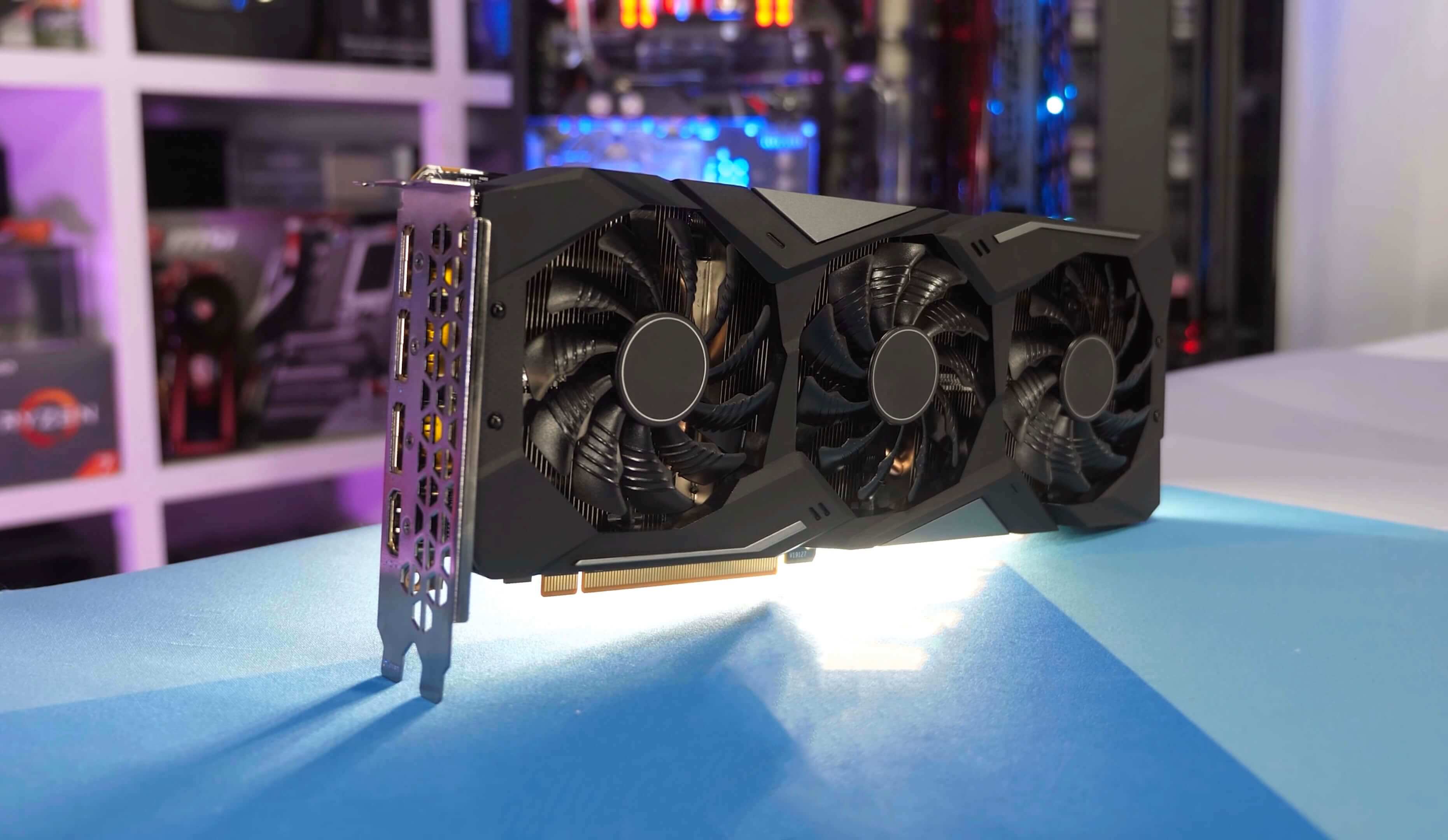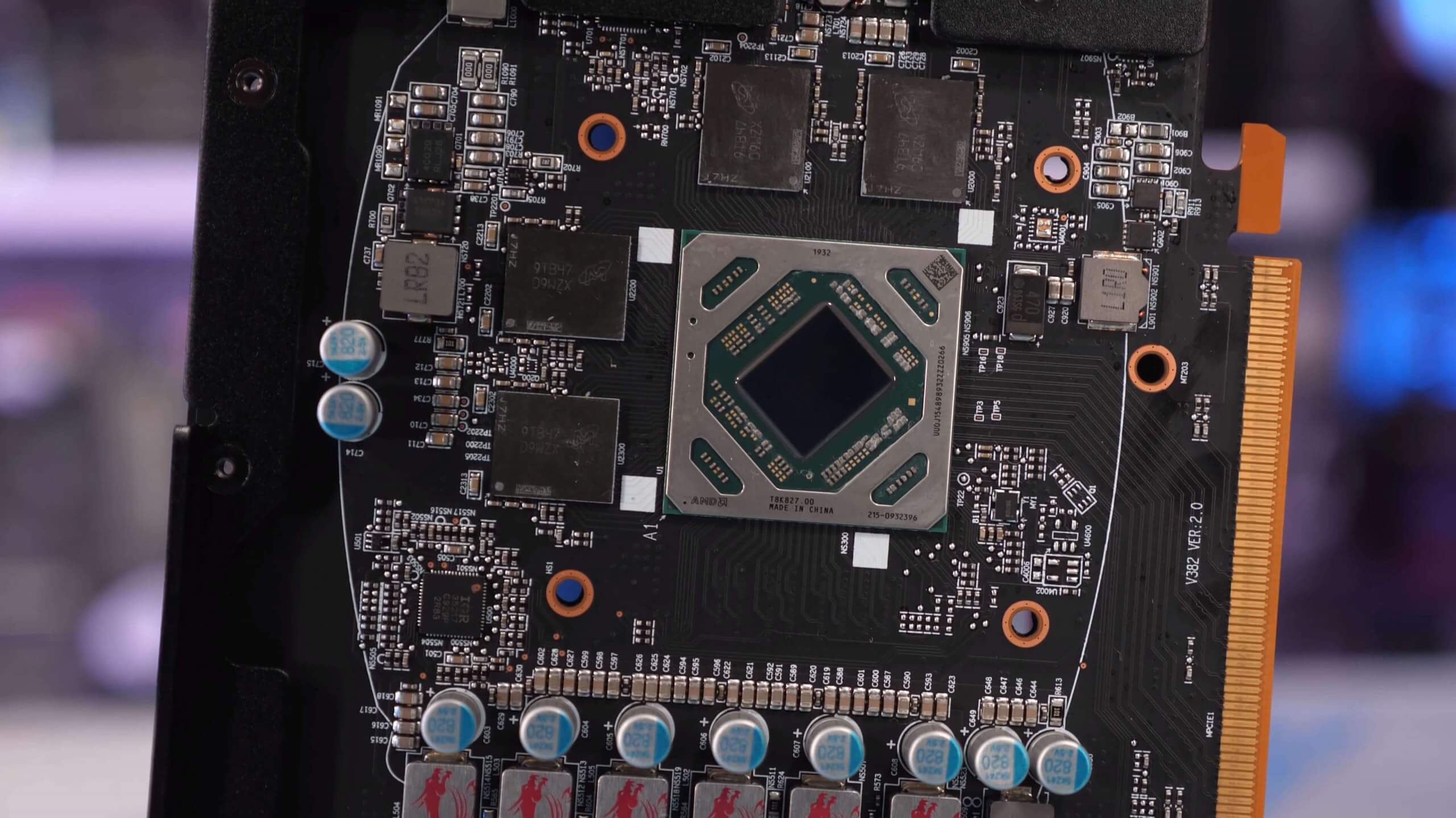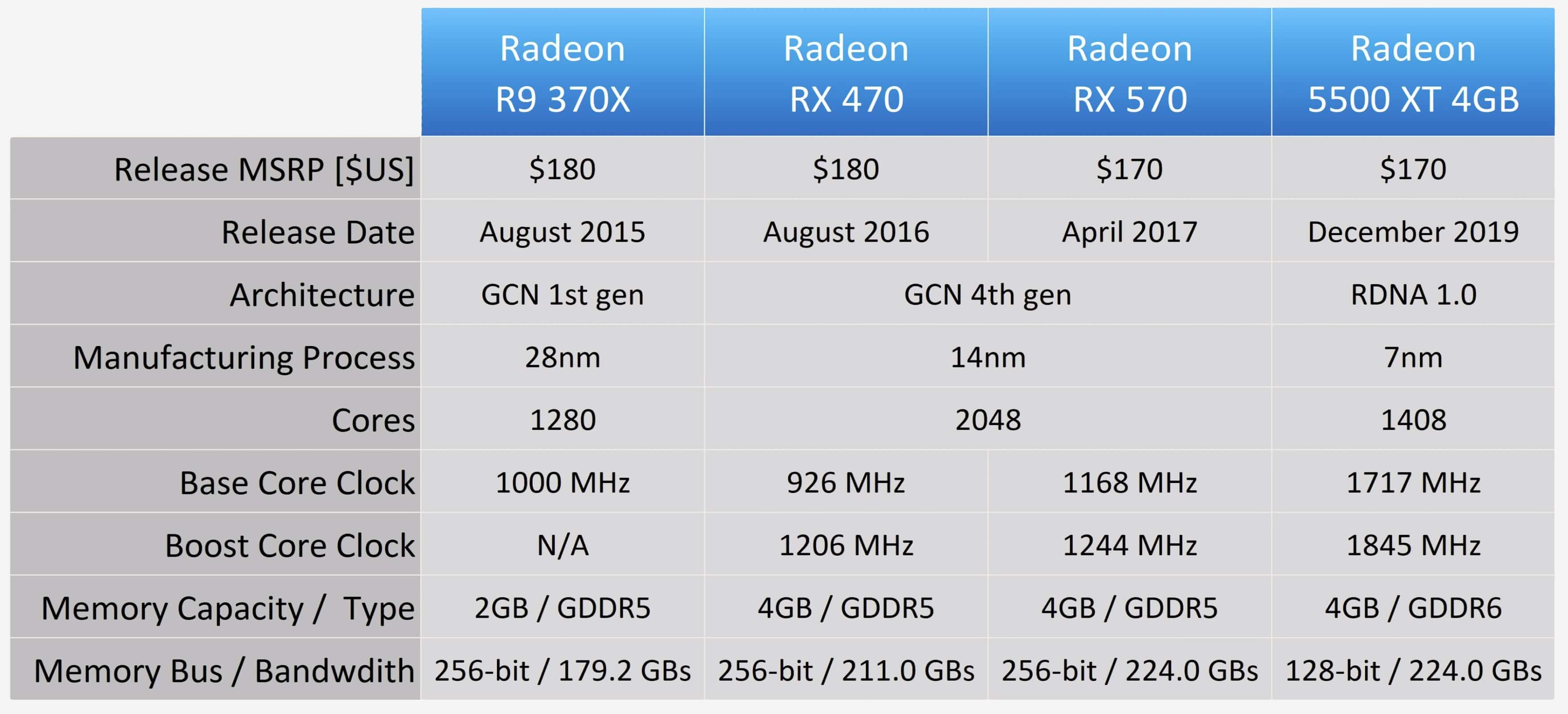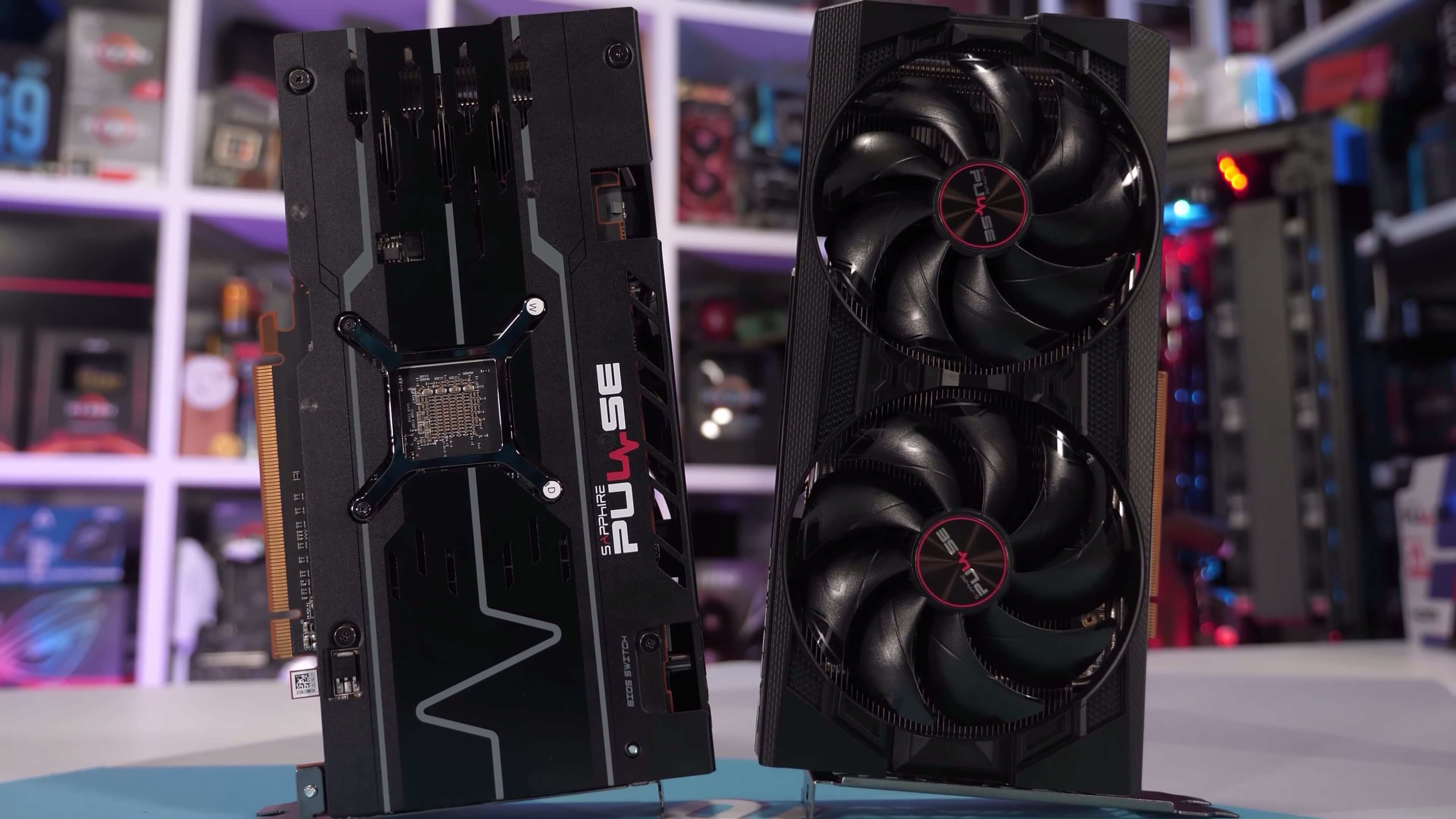Today we're going to review the sub-$200 graphics card market and see how it compares to what we were offered just a few years ago. We recently did this for the $400 price range and it was super interesting, pitting the GTX 1070 of yesteryear against today's RTX 2060 Super and the Radeon 5700 XT. We found that AMD offers a solid upgrade over past $400 products with the 5700 XT, which beat the GTX 1070 by ~50% on average. Meanwhile, the RTX 2060 Super was less impressive, offering a 35% performance bump.
We're definitely hoping to see some value added at the sub-$200 level. The most recent addition to this segment is the AMD Radeon 5500 XT. We reviewed it about a month ago, and in spite of offering solid performance relative to Nvidia's GTX 1650 Super, the 5500 XT pricing is a massive let down.
AMD is attempting to charge a small premium for this GPU that does nothing to improve the segment, meaning the 5500 XT isn't worth buying at the $170-200 MSRP. Worse still, the 5500 XT is limited to PCIe x8 operation which means you only get PCIe 3.0 x16 bandwidth when using a PCIe 4.0 enabled system and for that you need a high-end X570 motherboard.
After the disappointing 5500 XT release, we thought we could have a look at how the sub $200 market has progressed over the past 4 years or so. Our comparison includes the likes of the Radeon R9 370X and GeForce GTX 950, along with the Radeon RX 470 and GeForce GTX 1050 Ti.
Sub-$200 AMD Radeon GPUs
The Radeon R9 370X was released in mid-2015 for $180 as a 3rd generation refresh. Previously known as the R9 270 and 270X in late 2013, and sold for $180 and $200, respectively. These first-gen GCN parts all originated from the Radeon HD 7870 GHz Edition, released way back in 2012 for $350.
The Radeon RX 470 was launched in mid-2016 for $180 and was later refreshed, known as the RX 570 in mid-2017 for $170.
Sub-$200 Nvidia GeForce GPUs
As for the green team, the GeForce GTX 950 was released in late 2015 for $160. This GPU wasn't a refresh and it didn't get refreshed either. Following on in late 2016 was the GeForce GTX 1050 Ti for $140. Three years would pass before a replacement was issued for this card. The GTX 1650 saw the light in 2019 for $150, and was effectively replaced by the 1650 Super at $160 late last year.
That's the history, now let's get into the testing.
All graphics cards were benchmarked in our Core i9-9900K test system using the latest drivers and game versions available at the time of testing. Out of curiosity we've also included the 2013 Tomb Raider reboot in today's benchmark suite to see how the GPUs compare in an older title.
Game Benchmarks
The first game in our lineup is Battlefield V and here the Radeon R9 370X and GTX 950 are our baseline, both averaging 35fps. The 1050 Ti which wasn't the most exciting product offered a 37% performance boost, which is much more than the 22% boost the 1650 offers over the 1050 Ti. You can see why we were so down on the original GTX 1650. Within the same year the 1650 Super was released and it's 67% faster than the GTX 1050 Ti. This is obviously what the 1650 should have been.
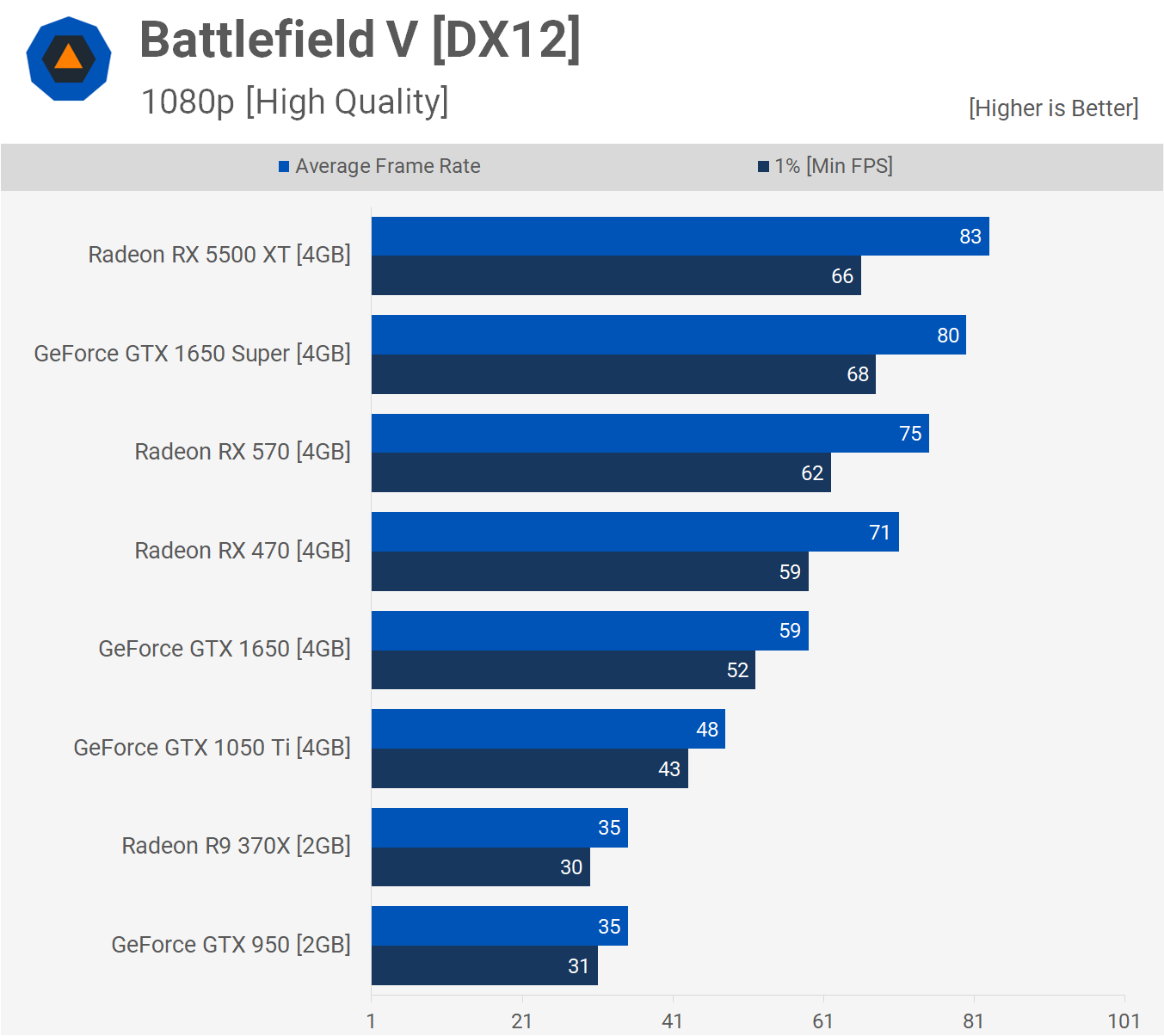
As for AMD, we see that they managed a massive 103% performance boost from the 370X to the RX 470 and the 470's MSRP was lowered by $10. The 570 refresh though was a lot less exciting, here we're looking at a mere 6% performance boost. Then from the 570 to the 5500 XT a further 11%, not exactly inspiring stuff from the red team. Basically they overachieved with the 470 and it's come back to bite them.
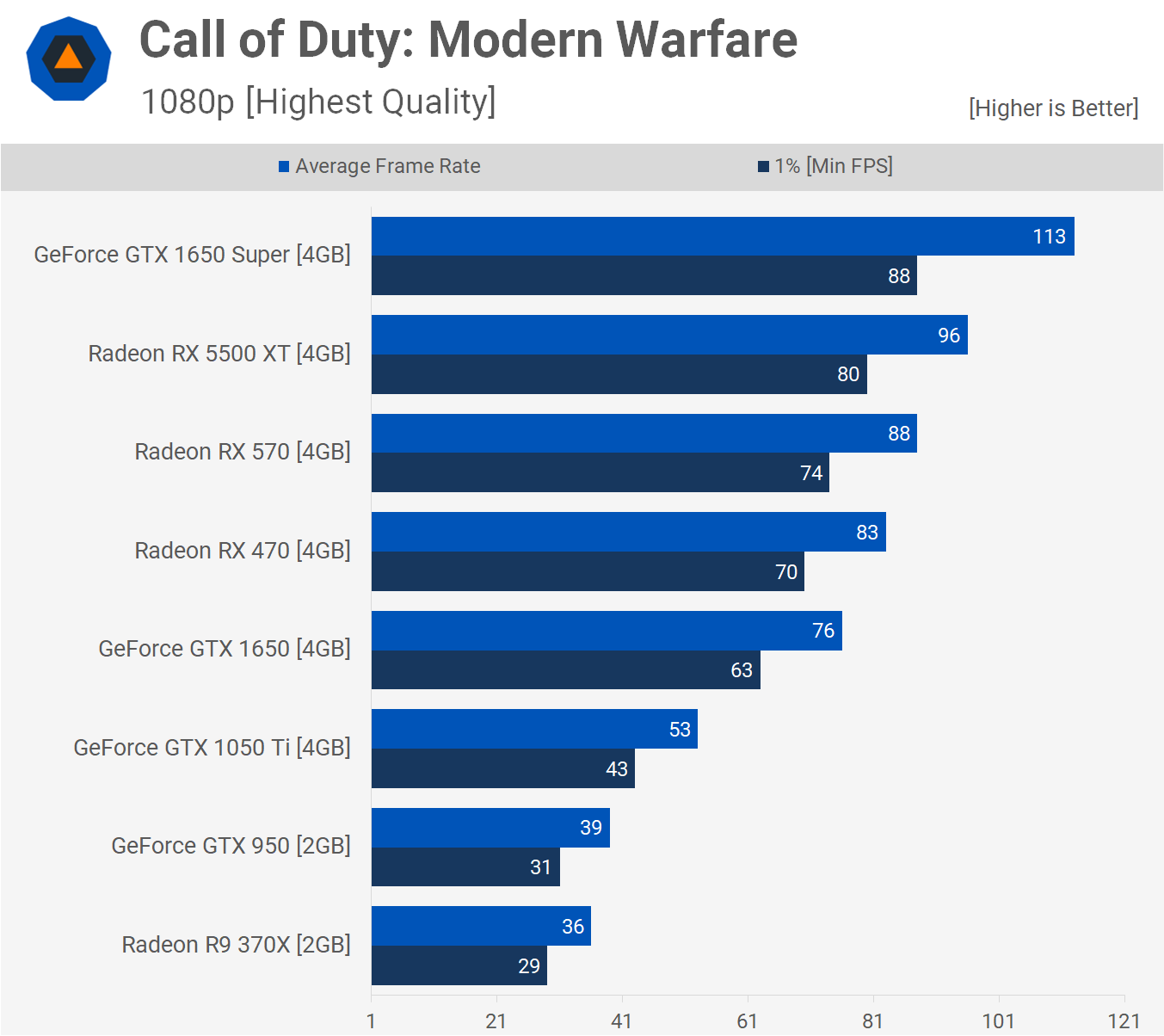
This time when testing with Call of Duty Modern Warfare we see a solid 36% boost for the 1050 Ti over the 950 and then a rather massive 43% jump up to the GTX 1650. That said, the GTX 1650 Super was still almost 50% faster than the vanilla 1650 and that meant it was a whopping 113% faster than the GTX 1050 Ti.
Comparing the 1650 Super to the GTX 1050 Ti can be a bit misleading though, as the Pascal GPU was always terrible value. Realistically we're looking at a RX 470 for 2016 performance and doing so meant the GTX 1650 Super is just 36% faster, so not as great.
Worse still, in this title the 5500 XT was a mere 16% faster than the RX 470.

The GTX 950 is the best of the 2015 GPUs in F1 2019, but even so the RX 470 was a whopping 106% faster.
But from the RX 470 we're looking at just 16% increase with the 5500 XT, a pretty miserable bump after all these years. Remember the RX 470 was released at just $180, the 4GB 5500 XT costs $170.

The Far Cry New Dawn results are interesting, here the GTX 1050 Ti was 14% faster than the GTX 950 while the GTX 1650 was 23% faster than the 1050 Ti. The ~70% jump from the GTX 1050 Ti to the 1650 Super is very impressive, but again it's really the RX 470 that we should be using for comparison here and the 1650 Super is about 21% faster and the 5500 XT isn't much better.

Testing with Gears 5 shows a 76% performance boost from the GTX 950 to the RX 470. That's obviously a significant performance uplift. But from the 470 to the 5500 XT we're looking at less than 30% increase.

We see a 76% boost going from the GTX 950 to the RX 470, this time when testing with Star Wars Jedi: Fallen Order. A milder 28% boost from the 470 to the 1650 Super is seen. These results also prove how terrible the GTX 1650 is, putting numbers just 15% faster than the GTX 1050 Ti.
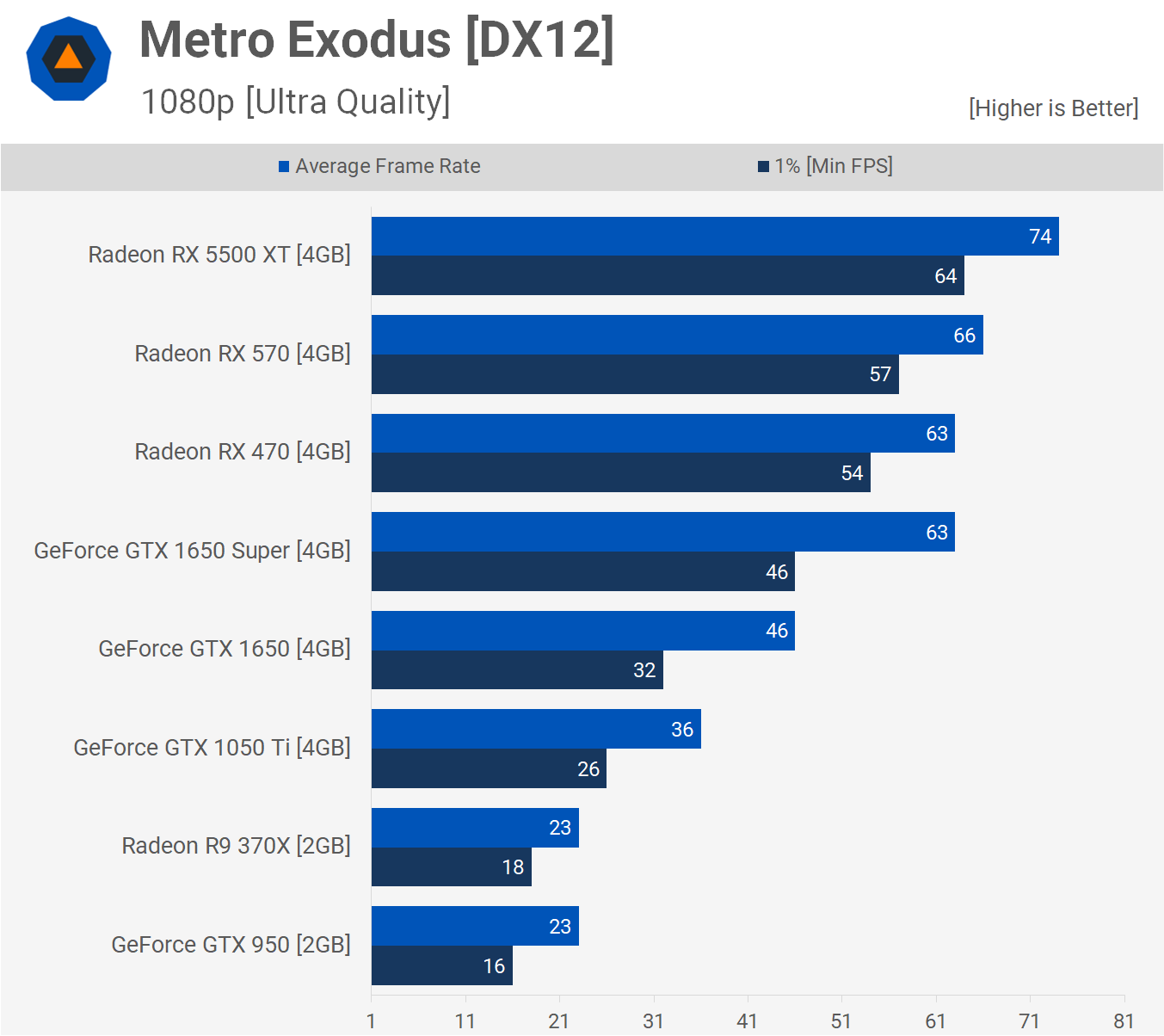
Unlike the other titles tested, Metro Exodus was benchmarked using the ultra quality settings and this seems to cripple the newer GeForce GPUs in the GTX 1050 Ti, 1650 and 1650 Super. The 1650 Super is only able to match the RX 470, but even so the 5500 XT was just 17% faster than the RX 470.

The Rainbow Six Siege results look much like many of the other titles already tested. Here the GTX 1650 does well thanks to the improvements made by the Turing architecture, but it's still behind the old RX 470. The GTX 1650 Super and 5500 XT were between 20-30% faster than the 470.
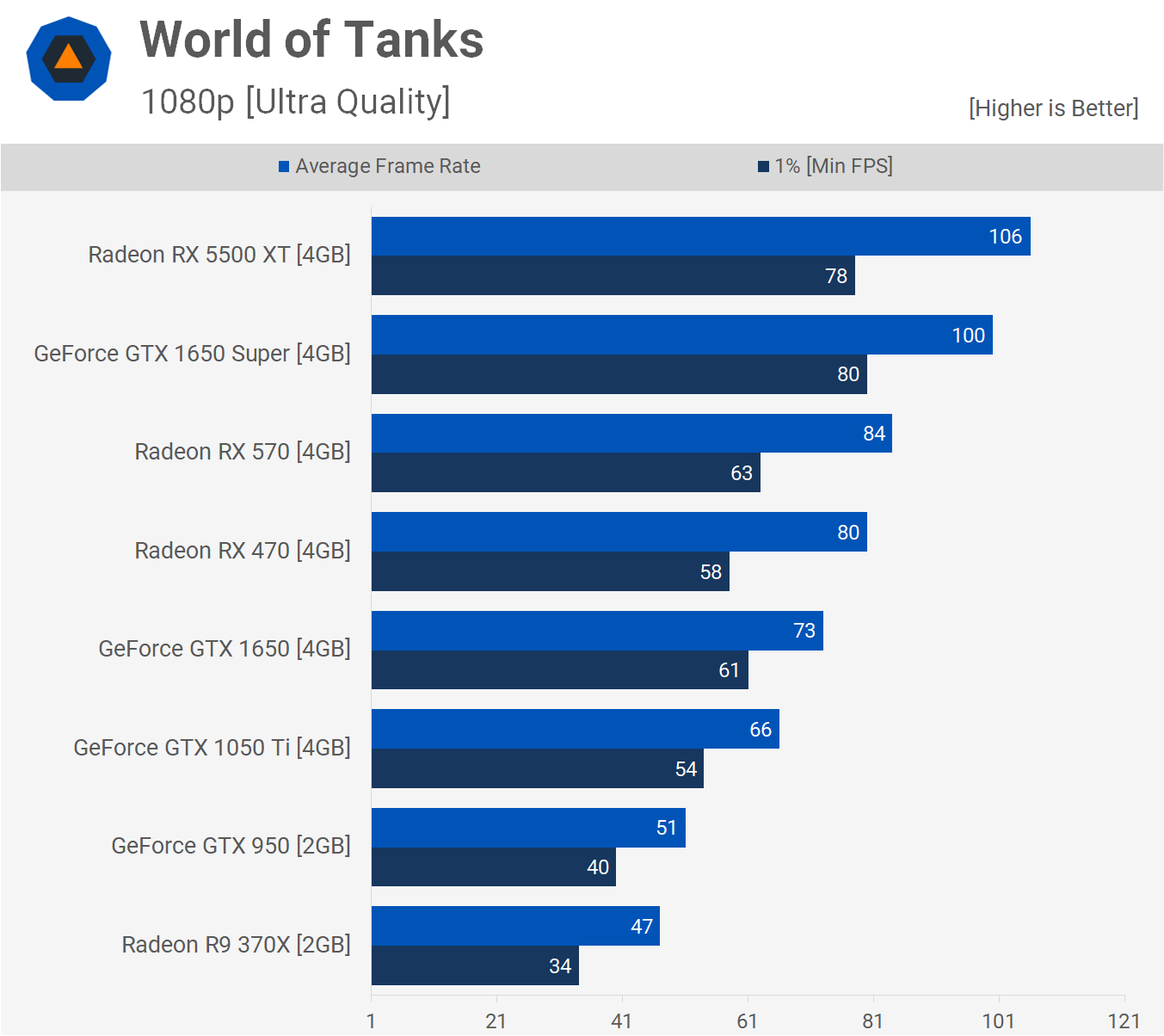
World of Tanks isn't heavy on VRAM usage so it's a good title for comparing the older 2GB models. Here the GTX 1050 Ti was 29% faster than the GTX 950, while the original GTX 1650 was just 11% faster than the 1050 Ti.
While the RX 470 was 70% faster than the R9 370X, the 5500 XT was 33% faster on top of that.

Using the high quality preset in Assassin's Creed Odyssey is hard on 2GB graphics cards and as a result the GTX 1050 Ti was 46% faster than the 370X and 64% faster than the GTX 950.
The GTX 1650 was just 27% faster than the GTX 1050 Ti and matched the much older RX 470. Meanwhile, the 5500 XT was 31% faster than the RX 470.
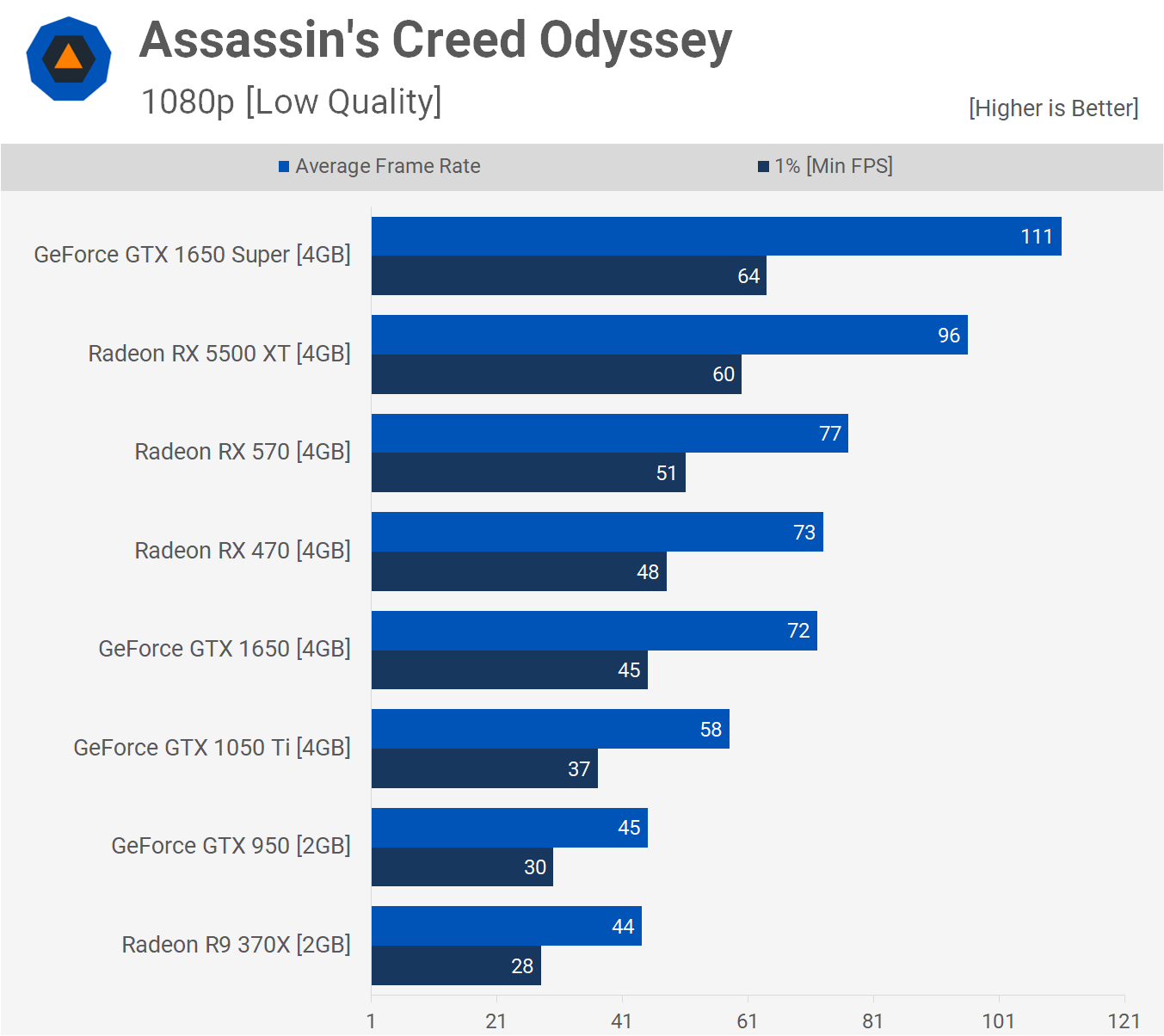
We decided to re-test Assassin's Creed Odyssey using the low quality preset, which is the lowest graphics preset the game has to offer. This time the 1050 Ti was 29% faster than the GTX 950. The margin from the 1050 Ti to the 1650 was similar, but this time the Turing GPU offered a 24% performance boost.
The new Radeon 5500 XT was just 31% faster than the RX 470, but interestingly the GTX 1650 Super does much better and is now 52% faster.

The last game we tested is 2013's Tomb Raider reboot using the ultra quality preset. Here the GTX 1050 Ti was 28% faster than the late-2015 GPUs, while the RX 470 was 84% faster.
The (vanilla) GTX 1650 again proved it's a forgettable product and why we criticized it so heavily upon release. We also see that the 5500 XT is 24% faster than the RX 470, while the GTX 1650 Super was much better (46% faster).

We're not too concerned with power consumption for this comparison, but we know some of you will appreciate the data, so here you have it.
Performance Summary
For those looking to spend less than $200 on your next graphics card, or are hoping to upgrade from a previous GPU at this price point like the Radeon RX 470, the latest offerings don't offer a big enough jump unfortunately. Of course, this will all depend on the GPU you already own, the RX 470 just happens to be the best of the older graphics cards.
Let's take a look at an 11 game average looking at all the modern games tested.

On average, the Radeon RX 470 was 90% faster when compared to the 2015 competition, namely the GTX 950 and RX 370X. That means that at the time, in one year the ~$170 GPU segment received an incredible 90% performance boost. If we ignore the RX 470 and look at the GTX 1050 Ti, we see a more mild 33% boost over the GTX 950, but in the 1050 Ti's defense it did come in at the lowest MSRP of all these products.
Still we'd say the jump from the GTX 950 to the 1050 Ti was pretty weak. Then the jump from the 1050 Ti to the original 1650 was even weaker. The Turing-based GPU was 25% faster than its predecessor but shockingly 12% slower than the RX 470.
The GTX 1650 Super helped to point things in the right direction, with a 23% boost over the RX 470. The same goes for the more recently released Radeon RX 5500 XT. Again, if we ignore the RX 470, the 5500 XT and 1650 Super are 75% faster than the GTX 1050 Ti, which is a huge performance gain if you're coming from that GPU.
Below is a look at cost per frame comparing the release MSRP, meaning not current market value.
This graph is really telling though...

Look at the lighter blue 'cost per frame' bars. The GTX 950 which was the better value option of late 2015 comes in at a cost of $4.10 per frame based on up to date data. The GTX 1050 Ti offered a pretty substantial 34% reduction in cost per frame, while the RX 470 was very disruptive at a 41% discount.
Then years later the GTX 1650 comes in offering just a 5% discount over the 470, which is irrelevant because by then we already had the Radeon RX 570 which was a much better value.
The Radeon 5500 XT is 23% cheaper than the RX 470 per frame and just 14% cheaper than the RX 570, again when comparing the 570 at the MSRP, not the current market price. Point is, when comparing the launch prices the 5500 XT is at best offering a 23% discount over the RX 470, three years later, and the GTX 1650 Super is not much better.
Even if we ignore the amazingly good value RX 470 and look at the 1050 Ti, the story for modern GPUs is not great. The 1050 Ti was 34% cheaper than the 950 per frame, while the 1650 Super is just 35% better than the 1050 Ti per frame. The GTX 1050 Ti was released just a year after the 950, while the GTX 1650 Super was released three years after the 1050 Ti.
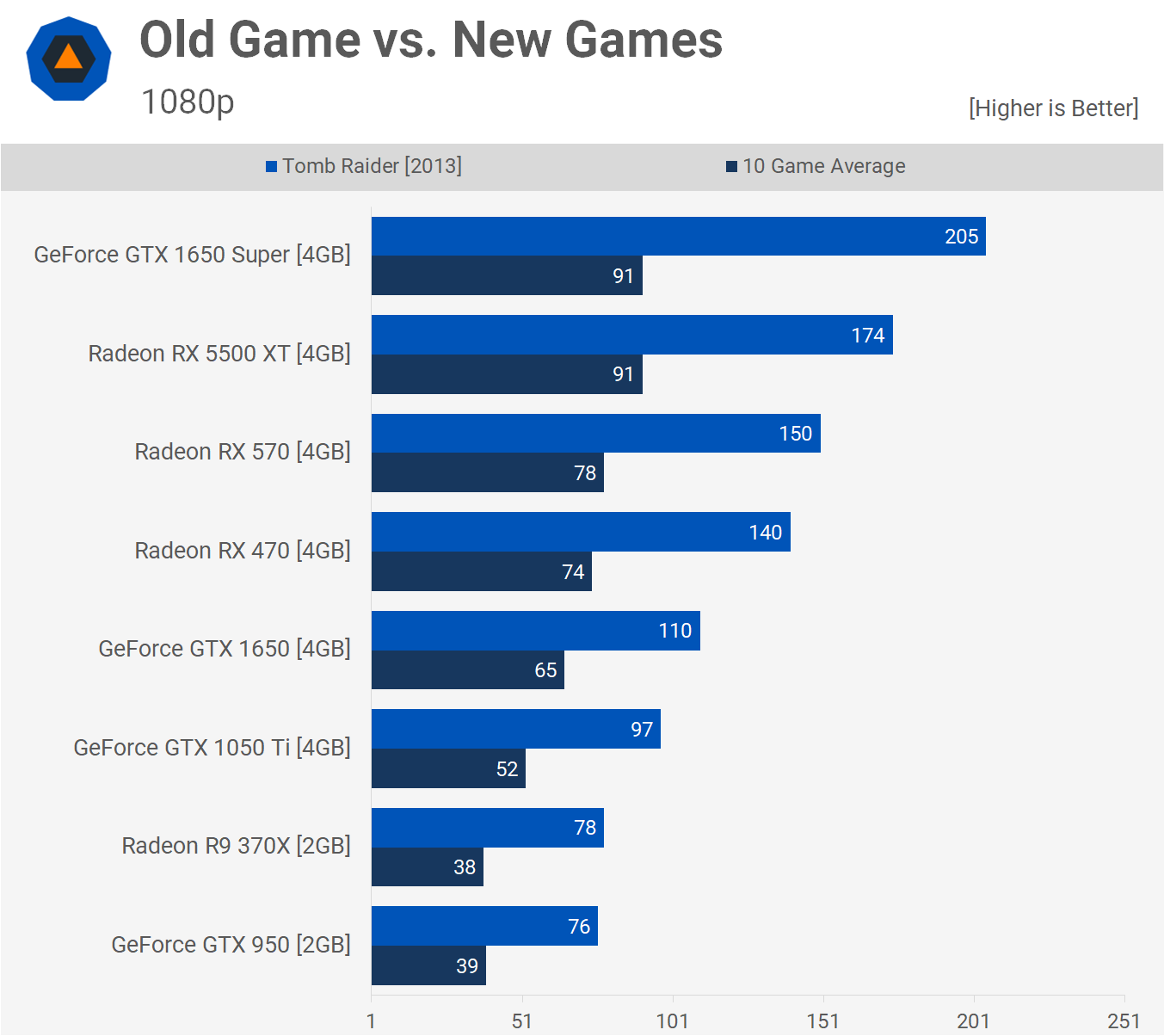
Lastly something that always comes up is the driver nerfing argument... so we decided to compare the 2013 Tomb Raider results to what we saw in the modern titles. Scaling between the old and newer games looks fairly consistent. The only standout here is the GTX 1650 Super which did better relative to the 5500 XT in Tomb Raider, but this is just a single title, so it's not surprising to see a result like this. In fact, we're really surprised how similar the scaling is for the most part.
The R9 370X and GTX 950, for example, were evenly matched in the modern and older games. Same goes for the GTX 1050 Ti and 1650, so we can't see any driver nerfing going on here.
What We Learned
Stagnation in the sub-$200 GPU segment is real. There's no 50% performance gains to be seen here and the RX 470 really does make a mockery of the GTX 1650 Super and RX 5500 XT. Even in terms of power consumption they're not overly superior: you're looking at a ~20% increase in performance for the same level of power usage after 3 years.
Ultimately what gamers really care about are frames and if you bought an RX 470 for $180 three years ago, you'll still be sitting around twiddling your thumbs waiting for a worthwhile upgrade at the same price point. Short of spending $350 on a Radeon RX 5700, you might as well keep making do with the 470 until something else comes along.
Shopping Shortcuts:
- GeForce GTX 1650 Super on Amazon
- AMD Radeon RX 5500 XT on Amazon
- GeForce GTX 1660 Super on Amazon
- GeForce GTX 1660 Ti on Amazon
- GeForce RTX 2060 Super on Amazon
- AMD Radeon RX 590 on Amazon
- AMD Radeon RX 580 on Amazon
- AMD Radeon RX 570 on Amazon
- AMD Radeon RX 5700 on Amazon
- GeForce RTX 2070 Super on Amazon
- AMD Ryzen 5 3600 on Amazon
